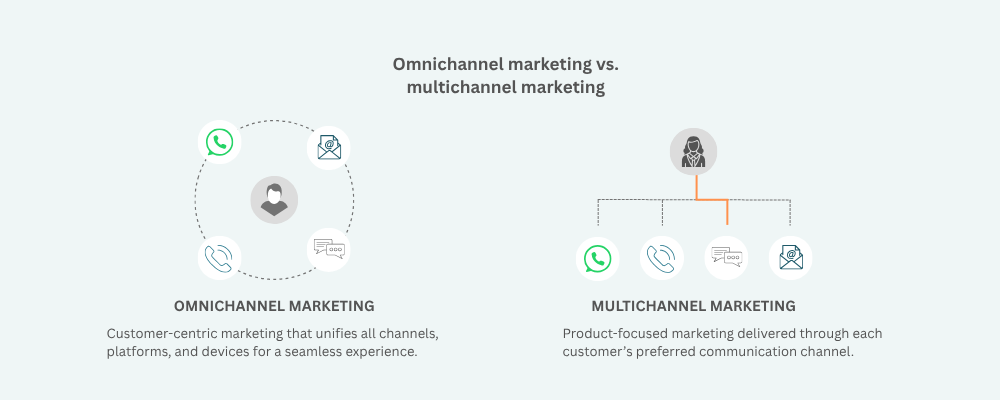Today’s customers expect seamless, consistent experiences across every channel when engaging with a brand. Yet, many marketing teams struggle to maintain that consistency. Striking the right balance between message frequency and relevance is essential to meeting customer expectations. When experiences feel disconnected, customers can become confused or frustrated – and may ultimately switch to competitors who deliver better.
An effective omnichannel marketing approach solves this challenge by connecting channels like web, social, email, and more into one cohesive, coordinated strategy.
What is Omnichannel Marketing?
Omnichannel marketing is the practice of using multiple channels and platforms to promote your business in a consistent, connected way. It’s about meeting customers wherever they are – and making every interaction feel seamless and natural.
Popular Channels for Omnichannel Marketing
Here are just a few channels you can use to create a connected, consistent experience for your customers:
- Social Media – Platforms like Facebook, Instagram, and LinkedIn are ideal for building brand awareness, community, and customer loyalty through posts, ads, and direct messaging.
- Website – Your website is the central hub for your brand. A mobile-friendly, easy-to-navigate site with strong calls-to-action is essential for converting visitors into customers.
- Email – Still one of the most popular channels for promotions and personalized recommendations. Email campaigns nurture leads, drive sales, and keep your audience engaged. Segment your list and tailor content for maximum results.
- Push Notifications – Deliver timely alerts, promotions, and updates directly to customers’ mobile devices to boost app engagement and conversions.
- SMS – Text messages have exceptionally high open rates, making them ideal for time-sensitive offers, reminders, and customer support.
- Messaging Apps (WhatsApp, Messenger, RCS, etc.) – Engage in real-time, conversational interactions. Share images, rich media, and interactive content to keep customers connected.
- Live Chat – Providing live chat support on your website enhances the customer experience, offering quick, convenient help without interrupting their journey.
The power of an omnichannel customer journey lies in using multiple channels in a coordinated, seamless way. When channels work together, they create a consistent, customer-first experience that strengthens relationships and drives more sales.
Omnichannel vs. Multichannel Marketing: What’s the Difference?
While both omnichannel and multichannel marketing involve connecting with customers across multiple platforms, the key difference is how these interactions are managed across channels.

Imagine you’re planning a holiday and start browsing hotels on a travel website.
With an omnichannel approach, the experience feels connected. You might receive personalized email suggestions based on your search, and when you’re ready to book, the website remembers your preferences and details – making the process quick and seamless.
- Omnichannel marketing focuses on creating a seamless, connected experience by understanding the customer and carrying that insight across all touchpoints.
- Multichannel marketing gives customers multiple ways to engage but may lack the consistency and personalization of an interconnected journey.
With a multichannel approach, the experience can feel disconnected. You can engage with the brand on various platforms, but your preferences or browsing history don’t follow you. You may even have to re-enter your information when switching channels.
Benefits of an Omnichannel Approach
Today’s customers expect more than ever – personalized experiences and consistency across every interaction with your brand.
An omnichannel approach delivers exactly that. It aligns with modern consumer expectations by creating a seamless, connected experience across all channels. This is especially critical for omnichannel ecommerce, where a typical customer journey might involve researching products online, visiting a store to see them in person, and completing the purchase through a mobile app or website.
With omnichannel, every touchpoint feels connected – building trust, improving convenience, and ultimately driving more sales.
Key Benefits of an Omnichannel Marketing Strategy
- Seamless, Unified Experience: An omnichannel approach ensures customers enjoy a consistent, frictionless experience across every channel. Consumers actively avoid brands that overwhelm them with disjointed messaging, a unified strategy builds trust and makes engaging with your brand effortless.
- Personalized Interactions: By gathering data from multiple touchpoints, businesses can better understand customer preferences and behaviours. This insight enables personalized experiences that boost engagement, satisfaction, and sales.
- Stronger Brand Visibility: A consistent message across all channels increases brand recognition and awareness. The more cohesive your presence, the more memorable your brand becomes.
- Higher Revenue Potential: A smooth, connected customer journey encourages purchases. When customers feel understood and valued, they’re more likely to buy – and buy again.
- Enhanced Data & Insights: Partnering with a CPaaS (Communications Platform as a Service) provider brings your data together in one place. This unified view of the customer journey empowers smarter decision-making and campaign optimization.
- Competitive Advantage: An effective omnichannel strategy helps you stay ahead of the competition. Providing a seamless, personalized experience attracts new customers and increases retention.
- Increased Brand Loyalty: When customers experience consistent, personalized interactions across all channels, they’re more likely to stay loyal. A brand that understands their needs and simplifies their journey keeps them coming back.
How to build your omnichannel marketing strategy
Creating a strong omnichannel marketing strategy starts with a clear plan. Follow this simple process to build a consistent and connected customer experience across every channel.
1. Identify the Right Channels
A successful omnichannel strategy starts with knowing where your audience actually is. Rather than spreading yourself thin across every platform, focus on the channels your ideal customers already use to find information, connect, and engage.
Here are three practical ways to pinpoint the most effective channels:
- Customer insights: Ask your audience directly. Use surveys, feedback forms, or social media polls to discover their preferred ways to engage – whether that’s email, Instagram, WhatsApp, or in-store.
- Competitive analysis: Look at what your competitors are doing. Which platforms are they active on? If they’re seeing traction, there’s a good chance your shared audience is there too.
- Social listening tools: Tools like Meltwater or Sprout Social can help you monitor online conversations around your brand and competitors. This reveals where your audience is already talking – and listening.
By focusing your efforts on the right channels, you can deliver targeted, consistent messaging and avoid wasting time and budget where it won’t pay off.
2. Craft Consistent Brand Messaging
Your brand messaging is the foundation of how customers perceive you. It should clearly reflect your values, voice, and personality – no matter where people encounter your brand.
In an omnichannel strategy, consistency is everything. While the format and length of your message may shift from channel to channel, the core message should remain the same.
This applies across all touchpoints, including:
- Your website
- In-store signage
- SMS
Each platform has its own strengths. A detailed offer may work well in an email but needs to be condensed for Instagram or SMS. The key is adapting your message to fit the format – without diluting the brand essence.
Done right, this consistency builds a cohesive, trustworthy, and instantly recognizable brand presence across every customer interaction.
3. Segment and Personalize Wherever Possible
The more you know about your customers, the more relevant your messaging can be – and relevance drives results.
Start by segmenting your audience based on factors like:
- Purchase history
- Browsing behaviour
- Demographics
With this data, you can deliver personalized experiences that actually resonate. For example, if a customer regularly buys running shoes, send them an email showcasing new arrivals in running gear – along with a discount to encourage another purchase. Or surprise a customer with a special offer on their birthday.
Tailored content like this makes customers feel seen and understood. And with the help of automation tools, personalization at scale becomes easy.
By segmenting smartly and personalizing intentionally, you’ll strengthen customer relationships and boost conversions – without wasting effort on one-size-fits-all messages.
4. Stay Relevant and Prioritize the Customer Experience
Omnichannel marketing isn’t just about promoting your products – it’s about delivering an experience that keeps customers coming back.
Start by staying relevant. Monitor industry trends and evolving customer needs so you can adapt your messaging and offerings to address real pain points.
Just as important is focusing on the overall customer experience. Every touchpoint – whether online or in-store – should be seamless, helpful, and enjoyable.
This is where tools like conversational AI come in. Imagine a virtual assistant that can answer questions, offer tailored product suggestions, and even process orders – available 24/7 across all channels. It’s instant, personalized support that improves satisfaction and builds loyalty.
Forward-thinking brands are already integrating generative AI into customer journeys – from live chat and email to voice and search. These innovations are reshaping CX by reducing friction and enhancing every interaction.
5. Measure and Optimize Continuously
To know if your omnichannel strategy is working, you need to track the right metrics – and act on them.
Key performance indicators (KPIs) to monitor include:
- Customer engagement: Click-through rates, time on site, and interaction rates show how well your content connects with your audience.
- Conversion rates: Track actions like purchases, sign-ups, or downloads.
- Return on investment (ROI): Understand the financial return versus your marketing spend.
- Customer lifetime value (CLV): Measure the long-term value each customer brings to your business.
These insights help you identify what’s working, uncover gaps across channels, and refine your approach for better results.
Here’s how to optimize effectively:
- Run A/B tests: Test variations of subject lines, creatives, or CTAs to see what performs best. Small changes can drive big improvements.
- Leverage a unified marketing platform: A centralized solution lets you track KPIs, manage data, and optimize campaigns across all channels – ensuring everything works in sync.
By making data-driven decisions and optimizing regularly, you’ll evolve your omnichannel strategy into a customer-centric engine for long-term growth. When you break down silos and deliver a seamless experience across every channel, you strengthen customer relationships – and see real results in sales and ROI.
Ready to take the next step?
Need a hand? Our team is here to help you design an omnichannel experience your customers will love.

